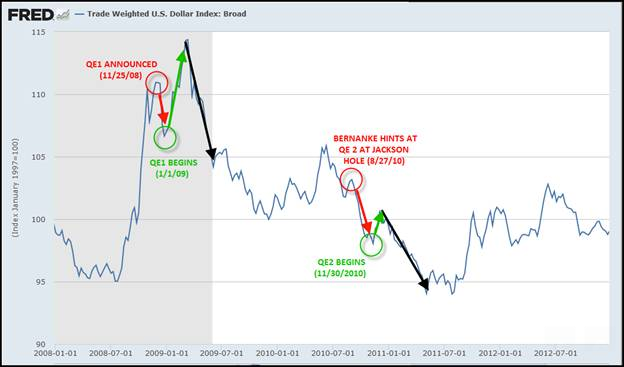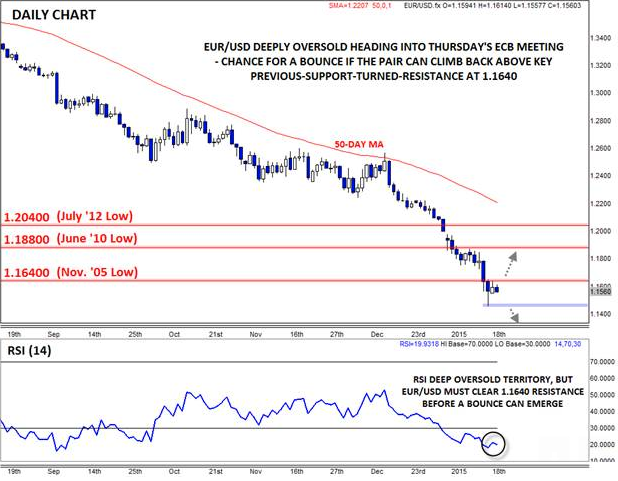Quantitative Easing is bad for currencies, right? By definition, QE is a policy that seeks to stimulate the economy by increasing the monetary base, or supply of money, in an economy, and as we all know from Economics 101, a greater supply of a currency lowers it value. This framework is undoubtedly true in theory, but as the 20th century baseball legend Yogi Berra once noted, “In theory there is no difference between theory and practice. In practice there is.” In other words, the actual market reaction to a QE announcement by the ECB on Thursday may not be as simple as “sell euros.”
The key to understanding the impact of QE on markets is the “surprise factor,” or the idea that QE programs only have a large immediate impact when they are not anticipated. Recent studies by the Federal Reserve and other central banks have shown that unexpected changes to monetary policy tend to have much more significant market impact than announcements that were widely anticipated.
The Federal Reserve’s experience with QE1 and QE2 clearly show this concept in action. Flashing all the way back to late 2008, the US mortgage market and broader economy were in disarray, prompting the Fed to announce that it would start buying mortgage-backed securities on November 25, 2008. Because this announcement was widely unexpected, the dollar fell 5% over the next month (the red arrow in the chart below) before actually rallying to new highs once the purchases began (green arrow). Astute traders will note though, the long-term impact of the QE program was dollar weakness (black arrow).
A similar situation emerged in the period around the QE2 announcement two years later. Fed Chairman Bernanke heavily hinted that the central bank would soon announce another iteration of quantitative easing in his Jackson Hole speech in late August, stating that the Fed would “do all that it can” to support the economy and that “The Committee [was] prepared to provide additional monetary accommodation through unconventional measures if it proves necessary.” With this transparent signal, traders sold the dollar in anticipation of QE2 (red arrow), and when the program was actually instituted, the dollar saw an immediate bounce before eventually continuing lower.

Source: FRED, FOREX.com
As William Shakespeare once wrote, “What’s past is prologue.” The ECB has been alluding to a new QE program for months, driving EUR/USD to an 11-year low around 1.1500, similar to the red arrows in the above chart. Especially after last week’s SNB decision, expectations are for a massive QE announcement from the ECB on Thursday, potentially even in excess of the rumored EUR 500B program from two weeks ago. If Draghi and company fail to clear this formidable hurdle, a kneejerk rally in EUR/USD seems likely.
Technical View: EUR/USD
Turning our attention to the EUR/USD chart, the pair is now deeply oversold after its prolonged downtrend, with its 14-period RSI indicator now around 20. Rates have broken through support level after support level over the last eight months, and those previous support levels may now provide resistance on any bounces. Accordingly, it would be prudent for EUR/USD bulls traders to see whether the pair can recapture the November 2005 low at 1.1640, potentially opening the door for a short-term recovery back toward the June 2010 trough at 1.1880. On the other hand, a larger-than-expected QE announcement on Thursday could still lead to more weakness in the single currency; the next support level to watch to the downside is last week’s low around 1.1460, with potential for more downside toward the long-term 61.8% Fibonacci retracement around 1.1200 if that floor is broken.

Source: FOREX.com
For more intraday analysis and market updates, follow us on twitter (@MWellerFX and @FOREXcom)
